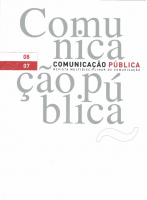Relationship marketing
como uma estratégia de co-branding pode ser relevante numa abordagem relacional ao mercado — o caso Nike+
DOI:
https://doi.org/10.4000/cp.12773Keywords:
relationship marketing, brand customer relationship, customer brand equity, co-branding, brand buildingAbstract
Implementing a Relationship Marketing approach sets the Client as the primary focus, under which all Marketing Mix is structured for building Brand Loyalty, becoming the Brand more profitable and effective on the long term. Trying to assure a stable, profitable and long-lasting relationship for both parts (client and brand) may lead to Co-Branding strategies in mature business sec-tors, where the need for differentiation and better products is supported on Relevance and Credibility. This study tries to analyze how a Co-Branding strategy can build value for the brand’s Customer Brand Equity. The partnership between Nike and Apple express that strategy.
Downloads
References
Aaker, D.A. (2002). Brand leadership. London: Simon&Schuster.
Berry, L. e Parasuraman, A. (1991). Marketing services. New York, NY: The Free Press.
Blackett, T., & Boad, B. (1999). Co-Branding. New York NY: St. Martin’s Press. DOI : 10.1057/9780230599673 good / bad
Kapferer, J.N. (2008). The new stategic brand management (4th ed). London: Kogan Page Limited.
Keller, K.L. (1998). Stategic brand management. New Jersey,NJ: Prentice-Hall.
Kim, C., & Mauborgne, R. (2005). Blue ocean strategy. Boston,MA: Harvard Business School Press.
Peppers, D., & Rogers, M. (2005). Return on customer. London: Cyan Communications Limited.
ARTIGOS
Pels, J., Coviello, N., & Brodie, R. (2000). Integrating transactional and relational marketing exchange: a pluralistic perspective. Journal of Marketing Theory and Practice, 8(3), 11-20. DOI : 10.1080/10696679.2000.11501871 good / bad
Reichheld & Sasser (1990). Zero defections: Quality comes to service. Harvard Business Review, (Set-Out), 105-111.
Sheth, J., & Parvatiyar, A. (1995). The evolution of relationship marketing. International Business Review, 4(4), 397-418. DOI : 10.1016/0969-5931(95)00018-6 good / bad
ARTIGOS EM DOCUMENTOS ELECTRÓNICOS
Adamson A. (2007). Best to keep it simple. Landor. (internet), disponível em http://www.landor.com
pdfs/AAdmsn_KeepSmpl_US_9May07.pdf (Consult. 10 de Junho 2008).
Brymer C. (2004). What Makes Brands Great? Interbrand. (internet), disponível em http://www.brandchannel.com/images/papers/what_makes_brands_great.pdf (Consult. 5 de Junho 2008).
Landor (2006). Unlocking the secrets of successful brand building. Landor. (internet), disponível em http://www.landor.com/pdfs/BBVS06Summary_28Nov06.pdf (Consult. 20 de Julho 2008).
Leuthesser, Kohli, Suri (2003). 2+2=5? A framework for using co-branding to leverage a brand. (internet), disponível em www.metro.as/index.php/content/content/download/198/858/version/file/2cobranding.pdf (Consult. 1 de Junho 2008). DOI : 10.1057/palgrave.bm.2540146 good / bad
Prophet (2001). Brand-Customer Relationship: The Face of Your Business Strategy. Prophet. (internet), disponível em http://www.prophet.com/downloads/whitepapers/BCRFINAL.2003.pdf (Consult. 26 de Julho 2008).
Swystun J. (2003). The Catalysts for Branding. Interbrand. (internet), disponível em http://www.brandchannel.com/images/papers/Business_Driver.pdf (Consult. 5 de Junho 2008).
Downloads
Published
Issue
Section
License
Copyright (c) 2009 Direitos de Autor (c) 2009

This work is licensed under a Creative Commons Attribution-NonCommercial 4.0 International License.
Os conteúdos da Comunicação Pública estão licenciados com uma licença Creative Commons - Atribuição-NãoComercial 4.0 Internacional.


